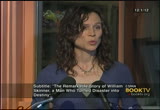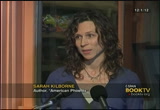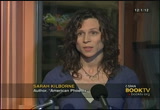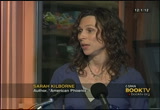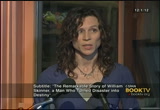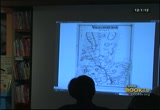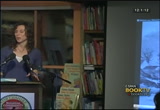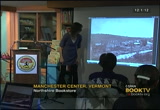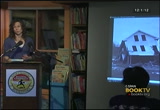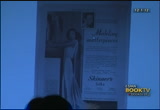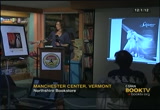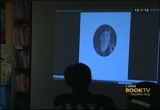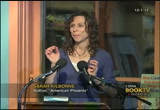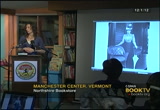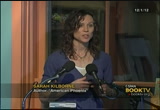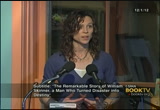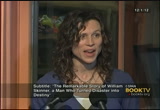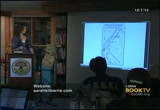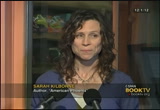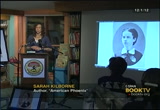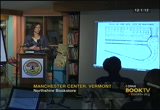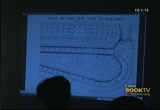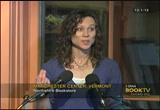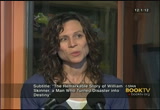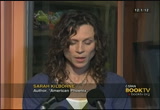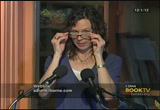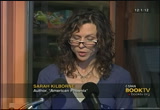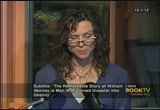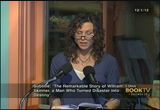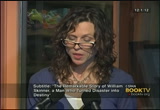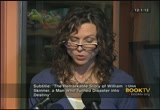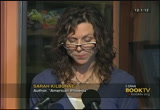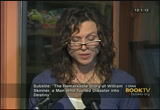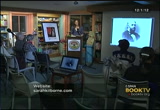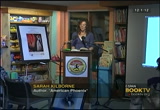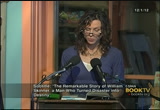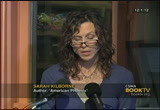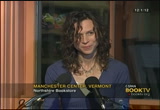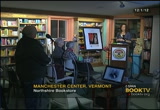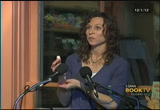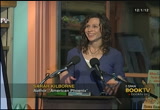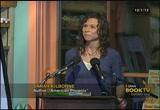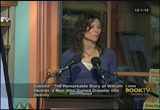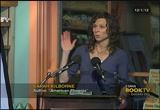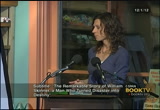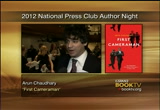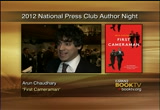tv Book TV CSPAN December 22, 2012 3:00pm-4:00pm EST
3:00 pm
>> thank you, bill. and thank you for your support of "american phoenix." and thank you all for coming out tonight, and thank you, cell phone r c-span and booktv, for being here. it's a real honor. and i'm thrilled to be able to share with you, "american phoenix," the remarkable story of a man named william skinner. so one question that every writer gets when people find out you're writing a book whether you're at a cocktail party, in
3:01 pm
the supermarket or on the street is, so, what's your book about? it's a fair question, and a good one. and often extremely challenging to answer because you have spent thousands of hours writing thousands of words, you have a ton of information if your head -- in your head, and you're writing one story, but that one story includes many other stories. and suddenly you have to figure out how to condense all this information, all these stories in a 15-second sound bite of ten words or less. well, i've got it down to three. well, seven, actually, if you include "american phoenix" is about. and one of the things that helped me get there was someone asked me, so, if your book were made into a movie, how would you pitch it? and i answers the titanic meets rocky. [laughter] "american phoenix" is about, in
3:02 pm
essence, disaster and survival. it's about disaster of epic proportions that involved a lot of water and engineering failure, the failure of design that killed a lot of people. and it's about survival, the triumph of the human spirit, the will to overcome extreme adversity, the ability to get back up when you've been knocked down again and again. so my book explores the challenge of having to rebuild your life after losing everything in an unexpected catastrophe. and it explores the discovery that sometimes our worst nightmares can turn into our greatest opportunities. it's particularly poignant for me to be here in vermont talking about "american phoenix" a year after the devastation caused by irene. because so many vermonters can relate to what william skinner went through 130-odd years ago having to rebuild their lives,
3:03 pm
their lives that have been now in ruin. and also now, given hurricane sandy, those down in new jersey and staten island and in queens and in brooklyn can also, unfortunately, relate to this challenge. what do you do. now, whether we come to the storyline with that kind of connection or not, we've all had disasters in our experience. we've all had those unexpected moments where something happens, and suddenly our life isn't the same as it was a moment before. everything is changed. we're in a new paradigm. and we have to figure out how do we survive. these moments of crisis test us. they test our instincts, our loyalties, our faith in ourselves, our creativity. they test our emotions, and they certainly test our courage.
3:04 pm
on may 16, 1874, a reservoir dam gave way in western montana. it unleashed an inland tidal wave that was at times 20-40 feet high and 300 feet wide. it roared down a 14-mile valley and swept through the villages of williamsburg, skinnerville, haydenville and the town of north hatchton. to give you a sense of the power of that water is to appreciate the amount of time it took to pass through portions of the valley. in the lower portion of the valley, the land levels out into an aleve y'all plain, and the town took about an hour and a half to flood into the town and into the connecticut river. in the upper regions of the valley where the land is sweeper, that water went through
3:05 pm
the villages in about 15 minutes each. it resulted in the worst industrial disaster in american history at the time. over a million dollars worth of property damage was sustained, almost 800 people were left homeless x139 people -- and 139 people were killed. my book is about the only village that wasn't rebuilt, skinnerville. and the man at the center of that village, william skinner. and what sets skinner's story apart is the success he achieved after this disaster. now, skinnerville suffered the worst destruction of all. it was considered to have been obliterated from the face of the earth. there wasn't a brick left of skinner's mill, his house was very nearly the only one left standing, and he lost more financially than any other individual. in those 15 minutes, he lost the equivalent of $35 million. he was ruined.
3:06 pm
but because he was willing to make choices that no one else was willing to make, he was able to come back. now, the other manufacturers in the valley who lost their mills and property tried to rebuild but were unable to do so successfully. within a number of years, they'd either gone out of business, they'd gone into bankruptcy, they'd had to sell their businesses, or they'd had to leave town. a local historian said just three years later, men of abundant means who seem to withstand the shock of disaster prove to be more embarrassed than was expected. but skinner, by himself, went on to rebuild his company. and as the sole proprietor, he carried it on, and he turned it into one of the most successful silk companies in our nation's history. when he died in 1902, his silk mill was the largest in the country, he was the top of the american silk trade, and he was
3:07 pm
a multimillionaire. now, the significance is that that success would never have been possible had he not lost everything and had to figure out how to survive making choices he wouldn't have otherwise been forced to make. skinner not only survived disaster, but he turned it into his greatest success. so this is a map of the town of williamsburg in 1873. and it shows -- this is the reservoir, that little kidney-shaped up at the top, and here's the village of williamsburg, skinnerville and haydenville. this is an image of the dam after it had given way. it was an earthen dam, it had a core wall of masonry, and this
3:08 pm
was all that was left of it. this is a graphic depiction showing the water surging past skinner's house during the flood. and they said that the house survived because its five chimneys rooted it to the ground, and it was made of board and not brick. the house is so large that it acted like a dam in the midst of the surge with the water surging around the front and back ends, crushing both of them, shattering windows, completely flooding the interior of the first floor. the back parlor floor collapsed under the weight of all the water and the flurry, and all the contempts fell into the -- contents fell into the cellar below. so as one reporter put it, potatoes and pianos, pictures and pork, books and bacon became terribly mix inside the flooded cellar. [laughter] this house, skinner moved with him when he relocated after the flood. it was taken apart piece by
3:09 pm
piece and transported on 25 railroad cars to the city of holyoke where he rebuilt. it is now a museum on the national register of historic places, and you can go and visit it and walk around it. this is an image of what was left of skinnerville after the disaster. and it's hard to imagine what it was like before. it was a thriving factory village filled with houses, trees, stone walls, farmland, and of course, skinner's silk mill. this right here is the foundation of what was, tsa all that was left of -- that's all that was left of the mill. and it extended far to the left of the familiar. this is skinner's house, you can see the front piazza has collapsed. this is an image that is the image on the cover of our book, my book, i should say.
3:10 pm
and there was no image, of course, of skinner's mill after the flood, because it was gone. so we had to choose one that represented the disaster. this is all that was left of a neighboring brass factory that was 600 feet long, or the length of almost two football fields. more devastation from the village of skinnerville. and here is a house that was lived in by the bartlett family in skinnerville, and many of the children in the bartlett family worked for skinner. one of his superintendents was henry bartlett and was working for him at the time of the flood. and the bartlett family lived in this house through the summer in exactly this condition because they had nowhere else to go. now, when skinner died in 1902, his sons -- owe and will -- joe and will -- took over the company. and they were a brilliant team. joe was a scientist, and he took
3:11 pm
over production at the mill. and ran the mill's lab. inventing all kinds of fabrics that involved silk. and will handled all the marketing and sales. and they carried on their father's style of innovation and pioneering in the manufacturing industry. skinner's was one of the first companies to branch out into consumer advertising. this is an ad from skinner's -- from good housekeeping, and i believe it's from 1903. 1907. here is an ad from 1931 featuring joan crawford. and skinner's silks and satins were a favorite of hollywood costume designers in the 1920s and '30s. and this, again, was part of will's doing. he wooed hollywood. and designers loved skinner's fabrics because they were not only beautiful and had extraordinary draping qualities, but they were durable.
3:12 pm
they could withstand the wear and tear of a costume on set. the men at the top of that advertisement is adrian, he was the head costume decipher of mgm, one of the most famous designers obviously the period -- of the period. and he actually helped advertise the products. i should also add that the whole advertising campaign that involved joan crawford and betty davis and other stars like that, the idea behind it was, of course, if you dress in skinner's silks and satins, you, too, can be a star. here's another ad from the mid 1940s, i believe it's glamour magazine in 1945. now, when returning soldiers came home from the war, they were getting married in droves. and their brides made skinners a household word in the united states.
3:13 pm
so many were getting married in skinner's bridal satin. it catapulted the company the a whole other level -- to a whole other level of success. now, the company survived until 1961. it was 113 years after skipper founded it in 1848. and the extraordinary impact that the company had throughout its existence was such that readers' digest actually include william skinner in the middle of the 20th century on the his of some of the most influential people on u.s. soil, and they had the larger readership in the country second only to the bible. i mentioned earlier that one of the questions that writers are asked is so what's your book about. shortly thereafter they will ask how'd you find your story. and how i came upon the story
3:14 pm
had to do with my family. william skinner was my great, great grandfather. here is an image of him around the age of 30. he has just lost his first wife, nancy. he's a widower in this photograph with his two young daughters. and he'd also just opened his silk mill in the area that would become known as skinnerville. i find this photograph haunting. the intensity in his eyes just burns, just sears you. he's so driven, he's so ambitious. and yet tenderly clutching his daughters. this is a photograph of his first wife, nancy warner, and she died shortly after the death of their second daughter, nina. skinner married again to a woman named sarah elizabeth allen, she was known as lizzie, and she is the woman after whom i am named.
3:15 pm
my full name is sarah skinner kilborne. and one would think with william skinner being my great, great grandfather i'm named after his wife, and that i would have grown up hearing about william skinner, the founder, and his story during the flood. i did not. that story seemed to have gotten lost in the legacy of the company. the company overshadowed its founder in the end. but i did -- well, and i should also add that there were only two things i knew about william skinner, and it shows how vague an impression i had of him. one was that i just barely knew that he was english, and the other is that i could only remember, only knew of one expression that he had which was very austere.
3:16 pm
remember, you are william skinner's descendants. do good in the world. that's all i knew of him. but i did grow up hearing about another member of the family. this is belle skinner. she was his second youngest daughter. and i was fascinated with her as a child and as an adult. she was a very famous philanthropist in france after world war i, and what she did was she legally adopted an entire village from the french government in the northeast of france. it was a leading -- legal, binding document. and she rebuilt it after the war. the french were going to abandon this village. they considered it so hopelessly bombed by the germans. and belle came in, she took it on, and it exists to this day because of her. and she was this larger-than-life figure. you know, she called the
3:17 pm
president of france ray ray, she had nicknames for everyone, and she signed her letters with oceans of love, she wore this fabulous hats, and she was very handsome and had this extraordinary, commanding presence is and worked with the french government to rebuild their country. and i wondered as i began to look into her life what would compel this woman, then in her 50s leading a very comfortable life, to become so passionately involved in resurrecting a devastated village? >> well, rewind. when she was 7 years old, the village which she was born in, skinnerville, was destroyed in a flood and never rebuilt. so i began to research the flood as an inroad into belle skinner's story. but as i began to learn more about the flood, suddenly william skinner began to come alive because he was so alive in
3:18 pm
the historical record. he was such a central figure in the disaster that the papers followed his every move, and as i'm reading the papers, suddenly i'm following his every move. and i knew how his story ended. he became a success. but as i learned about the extraordinary loss he suffered, what it took to get over that and come back from that, i became incredibly impressed with what he'd been able to achieve. his story is one of resiliency. never give up. obstacles are opportunities. for every problem there is a creative solution, you just have to find it. don't believe in luck, there is no such thing. you have to make your own luck. you have to work hard for what you want. don't believe in failure, believe in yourself. these were all things that skinner believed. now, he learned his resiliency as a kid.
3:19 pm
he was born into a slum of such poverty in london, it was considered without parallel in the kingdom. he was morn to a community of silk workers that had been making silk for generations, weaving and dyeing it, but they were called a stunted, puny race. an advocate for their welfare said that it is not that a few starve, but that so many are on the verge of starvation. it is not that some suffer, but that so few escape. well, skinner did escape. he came over to this country at the age of 20, and he had nothing of material worth with him, he was too poor. but he had one thing that no one in america had at that time, and it was an extremely valuable and tangible quality. or knowledge, i should say. and that was the knowledge of how to dye silk. there was no silk industry in this country at that time.
3:20 pm
no one knew how to dye it, they didn't know how to manufacture it, they didn't know how to make the machinery, they didn't have the tools for the man -- machinery, everything was trial and error to try to create a silk industry. it was the upbuilding of our domestic industries. it was our industrial revolution. how do we get in on this trade? there was so much money to be made in silk. and it's hard for us to appreciate today what it meant to our culture back then. but before the age of synthetic fabrics, before the age of designers, silk was the ultimate in style. it represented prestige, prosperity, success. so america wanted its own silk industry. skinner used to say there's not an irish servant girl who comes over to this country whose ambition is not to wear a silk dress. everyone wanted silk. so skinner came to this country with the knowledge that americans didn't have, and he became a pioneer in the american silk industry.
3:21 pm
he helped establish it, he became a founding member of the american silk association, and he parlayed that one skill -- how to dye silk -- into opportunity after opportunity to the point where he had his own silk mill. and it was so prosperous that an entire village had grown up around it. this poor kid from east london had literally put his name on the american map. now, in order to write my book, i had to recreate skinnerville, because with it disappeared after the flood. and here, again, is a map of skinnerville from 1873. oh, okay. i do need to go back. i'm not sure quite how to do that. um, well, okay. we can leave this here.
3:22 pm
so i have had to recreate skinnerville. how do you do that? looking through deeds, vital statistics and tax records, census documents. i should own stock in ancestry.com, i spent so much time and money on that web site. and with all of this i was able to put together what this community consisted of, who lived in what house and where, how many children did they have, who was pregnant at the time of the flood, who had given birth two days before the flood. but there's only so far you can go on your own. there are some things that do just come to you for which you are forever grateful. so one day i received a phone call from what was skinner's home that's a museum. and they told me that a collection of letters had just been donated by a descendant of
3:23 pm
some sisters who had worked for skinner in his mill in skipperville. and these -- skinnerville. and these letters opened up what it was like to live in the village, what it was like to work for skinner, what he was like as an employer, what it was like to be a mill girl in the middle of the 19th century living in a small factory village, boarding far away from home. and one thing that we may not realize is that at this time mill work was very respectable for a young woman. if you were ambitious and motivated, you could make a lot of money in a mill. it did not affect your character at all, and it was a way to have a sense of independence and make your own money. the sisters were the littlefield sisters. they're from upstate new york near troy, and the first sister to come was 20 years old at the time. she came in 1866, and she had
3:24 pm
been visiting some cousins who lived in chesterfield just north of williamsburg. and they hold told her skinner was looking for new workers. >> e e e applied, got the job and became an expert spooler. and that meant she worked in the finishing section of the mill. she would wind it on the actual spools that would go to market. it was a job that required tremendous skill because you couldn't damage the silk whatsoever. this was the silk that was going to be sold. she was fantastic at it. and another sister followed her, named francis, and this is what often happened. one sister worked in the mill, she would send word to her other sisters or siblings and say apply for a job, you know, come join me. and so within this mill community you had a number of siblings working together. it was very much a family environment.
3:25 pm
the third sister to come work for skinner was ellen littlefield. now, ellen outlasted both of her sisters at the mill, and she was working for skinner at the time of flood. she is the strongest female character in my book. after the flood. >> she also worked with skinner helping to salvage his silk, and she moved to holyoke and ultimately married his bookkeeper. now, after the flood the valley's loss was going to be or could be potentially someone else's gain. so after the disaster happened, the valley was a very popular spot for investors and capitalists. offers came from all over, from as far away as omaha, nebraska,
3:26 pm
to the manufacturers that had lost everything giving them incentives to move elsewhere and to relocate to other areas. one of the most vocal voices in this choir was that of holyoke, massachusetts. and holyoke was an ingeniously-designed city, specifically designed for industry. it was hoped to be even greater than the urban mill centers of lawrence. holyoke was considered to be the greatest potential mill power in new england. the dam that, it dammed the connecticut river on the right-hand side, right here, was at a crest of a 60-foot fall in the river and capable of generating power for 300 mills. the cotton lords that created holyoke on the model of lowell and lawrence devised a
3:27 pm
three-tiered canal system so that, unfortunately, it doesn't show in this map, but the canals come -- the first canal comes like this, and this comes like that, and that comes like this. so the connecticut river was able to be used over three times. now, holyoke made offers to the manufacturers in the valley, and can skinner's the only one who accepted the offer and moved. and he's the only one who survived. skinner knew he needed two things to be able to make a go of it again: he needed money, and he needed water power. in skinnerville he was going to have to rely on steam if he rebuilt there because the reservoir, which had supplemented the mill river during the dry season, was not going to be rebuilt. so going forward during those dry seasons when the river ran low, skinner was going to have to supplement his mill with
3:28 pm
steam. it was very expensive. for a man in the amount of debt he was in, it was too expensive for him at this time. he was also going to have to rebuild the entire infrastructure of the village for his workers, all the houses and everything there. and he needed a lot of water power for his operation to make, to dye zig you need -- silk you need a lot of water, and he, of course, since he did not want to convert to steam, needed the power to power his machinery. holyoke could offer him consistent water power 365 days a year without a reservoir hanging over his head that could possibly break away. and holyoke also offered him money. but better than that what they did was they said we will give you a property along the canal that's worth $6,000 for free for five years. you don't have the pay any rent.
3:29 pm
we will build you a new mill. you don't have to put a penny down. you just start paying interest payment at the first of the year for phi years. at the end of those five years, you can buy back the mill and the lot at its original cost. so skinner was literally able to get going again without having to put anything down. they said we will give you an acre of land for free, one on which to build a new home. skipper, of course, moved his old home and relocated to holyoke, but again, property he didn't have to pay for. if he had stayed in skinnerville, he would have had to have beared the burden of every single expense that he was going to incur. this is the first mill that skinner had in skinnerville. incredibly, it went up six months to the day of the flood.
3:30 pm
>> in holyoke? >> this is in holyoke, yes. and, ultimately, skinner's mill turned into that. this was the largest silk mill under one roof in the world. in 1874 success of this scope was impossible to imagine, as was what it would take to achieve it. in 1874 skinner thought he was at the head of his game. he felt at the head of his game. he was 49 years old, he had a wife and seven children, he had a village of about 200 people. this village had grown up around his silk mill, it was named after him, it was called skinnerville. he was at the head of the american silk trade at that time. he was bullish on the future, and he believed that silk in this country would become big
3:31 pm
business, which it did. but in 1874 he was thinking how can i expand my business today, how can i make it better today? skinner used to say what's the biggest room in the world? the room for improvement. [laughter] and in 1874 he was looking to improve his business, bullish on the future. he was looking ahead, what could he accomplish, what could he make of his mill in skinnerville, how could he become even better than he was? so with that, i will now read you an excerpt from the book, and then i'll take questions. now, i apologize in advance, i won't be able to read and look up at you all because i now need glasses, and, um, and i tend to slip on my nose if i look up and down. so i'm going to have to keep my nose in my book as i read.
3:32 pm
chapter one. on the evening of may 13, 1874, the tall, robust englishman walked through the door of delmonico's restaurant in new york city. he was neatly dressed in a black suit with satin trim, bow tie and embroidered waistcoat, the latter stretched impressively. he was greeted in the foyer by a host of familiar faces and several hands reaching out to shake his. an american custom to which he was, by the this time, accustomed. in that gentile environment, however, his cockney accent soon rang out like a clarion call at dawn, and one would have been hard pressed to find even a well-trained staffer who didn't raise a brow at the brashness of the tone. everything about william skinner stood out, each his head. since he didn't like hats and
3:33 pm
chose not to wear them despite their currency on the street. inside the restaurant which was housed in the old grinnell mansion on fifth avenue and 14th street, skinner joined about 70 gentlemen filing upstair toss a private banquet room. they hailed from a great many places, but they had one thing in common: silk. here were the leading manufacturers of the american silk industry along with several congressmen, some local politicians and even a japanese dignitary. skinner wasn't the only englishman among them, but at 49 he was one of the oldest, and he'd been specifically asked to give a toast this evening that would reflect on the past and honor the pioneers like himself who had turned american-made silk into an enviable addition to the marketplace. skinner hadn't wanted to be part of the lineup, he wanted to sit back and relax without the thought of having a speech to make, but at least one of his colleagues had successfully talked him into it.
3:34 pm
having grown up poor and uneducated, skin canner quietly harbored a sense of social inferiority. few could match his formidable language of the silk industry or his astonishing success therein. further, he had a flair for the dramatic and for all his instinctive hesitation to get up before a group of people, he possessed a natural ability to hold an audience's attention. this, along with the fact that he tended to keep things short, made him a popular speaker. nor would he let his peers down tonight. as skinner climbed the carpeted stairs toward the appointed dining room chatting with friends and colleagues, at least part of his speech was already written out and tucked away in one of his pockets. anyone who read the papers knew that to lunch, dine or sip at delmonico's was the crowning ambition of those who aspired to notoriety. a presence in this establishment, the most
3:35 pm
luxurious restaurant that had ever existed in new york, suggested irrefutable success socially and financially. banqueting here conveyed to the press and the public that this group of ambitious silkmen had arrived. their or tireless, determined and off brilliant endeavors had firmly established a silk industry in the united states. and at long last, a national organization devoted to their cause. tonight these men were celebrating the second anniversary of the silk association of america and the exhilarating truth that the american silk industry is, indeed, a power in the land. their private dining room had been festooned with flags with the u.s. flag and the flag of the empire of japan joined in solidarity at one end. banners from every state in the union were hanging throughout the room as well reminding each manufacturer that he was, indeed, part of a union, an
3:36 pm
industry of thousands of which he was a vital member. at the center of it all floated a sea of colorful balloons above tables glistening with silver and chris crystal. each balloon had been labeled with an industry trademark advertising thebred of -- breadth of american silk manufacturing. later on with toasts underway, the balloons served yet another purpose. the very ceiling would appear to rise up as the men raised their classes in unison, elevating the occasion still further. in keeping with the celebration, the menus had been printed on american silk in purple, blue and green with white fringe. like miniature silk scarves, they were soft to the touch and elegant to the eye, casting off
3:37 pm
a rich luster under the glow of the chandeliers. on the front they listed the exquisite bill of fare devised by new york's most famous chef, but with everything written in french -- as on any given night at the restaurant -- all this, of course, was quite unintelligible to many of the gentlemen present. the backs of the menus featured more-familiar english since this was where the evening's toasts were listed. down toward the middle was skipper's speech. we emulate our pioneers' example. by the time he stood up to present, a great deal of reminiscing would have already taken place, but his words the organizers hoped would put a flourishing cap on the topic. this dinner, after all, was nothing if not a jubilant reminder to all the men gathered that they were not only benefactors of the past, but progenitors of the future. they, too, were making history.
3:38 pm
two days later, skinner was on a northbound train heading up the connecticut shoreline on his way home to massachusetts. according to his regular schedule, he visited the city nearly every month. he was on the last possible train of the day which left the grand central depot at 3 p.m. and put him on target to reach skinnerville at 9:05. there was no dining car on the train. that amenity was as yet very rare, and there would be no 20-minute meal stop at any station along the way. unlike his glorious repast of two nights before, this evening's dinner would most likely be packed in a box or brown bag, just a few per funk ri rituals for a traveling businessman. as the train sped along past the white church spires of various new england greens, the afternoon sun began falling toward the west, and the temperature began dropping as well. the hill towns of western massachusetts, of which
3:39 pm
skinnerville was one, were known for their long winters. in the year 1874, it had been no exception. it had snowed for days at the end of april with heavy storms paralyzing the countryside. and can there was still snow on the ground in patches. but for the moment in that sun-streaked car, skinner was miles from any lingering wintrywet. outside the sky was clear, the tracks were clear x he was rapidly winding down one of the most rewarding business trips he'd ever had. skinner had just been hailed as a pioneer in his field. his speech was highlighted in the papers, and his industry was considered to be one of the most exciting in american. furthermore, his store downtown was filled with activity. he'd just hired a new salesman, a strapping young man named fred warner, and he was getting ready to expand his business again. skinner wanted to branch out into the manufacture of a thread
3:40 pm
use today make ribbons which were increasingly the rage. skinner already had the requisite machinery on hand, had apparently e represented an addition to his mill and had even hired a local architect to design no fewer than eight new tenements to accommodate the employees he expected to hire. as much as business may have preoccupied his thoughts though, he had something else on his mind though this friday. his 18th wedding anniversary was this very day, and hidden protected in his suit was surely a velvet-lined box from his favorite jewelry, louis tiffany, with something precious for his wife, lizzie. skinner, one of his granddaughters noted, loved giving things. and on a similar occasion when he'd been unable to be home on the day of his anniversary, he'd returned with a diamond scarf pin carefully selected and beautifully wrapped for the woman whom he called, my darling. skinner relied on his wife more
3:41 pm
than anyone. every bit as intelligent as her husband, lizzie was much better educated having attended both elementary and boarding schools and having herself worked as a teacher for many years. there seemed nothing this exceedingly capable woman couldn't do from layingly knoll yum to explaining mathematics. following the birth of their fourth child, she even helped handle affairs at the mill while skinner was away in england, and later she helped to run the mill's boarding house. she was intimately involved in her husband's business. but what set her apart was the fact that she was the wife of a rich manufacturer. there was no economic reason for her to be absorbing these responsibilities. she simply took them on, utilizing her amazing genius for organization and development. more than a wife to skinner, lizzie was a partner. skinner's first wife had died
3:42 pm
young, but lizzie had raised his children as her own and given birth to eight more as well. of these ten children, seven were still living, and adding to skinner's sense of accomplishment, all were thriving. nelly and nina, 23 and 20, had grown into smart, educated young women under their stepmother's tutelage. nelly had graduated from a boarding school in connecticut where she'd studied french with none other than george columnen sew who was on his way to becoming prime minister of france. nina had gone a step further, entering college with both of her parents' resounding blessing. she was attending vassar in poughkeepsie, new york. lizzie easeleddest, will, 17, was about to close out his high school years at the prestigious seminary in nearby hampton, massachusetts. graduation was just a few weeks away; that is, if he could make it without being expelled. will was charming, handsome, and much to his parents' dismay,
3:43 pm
completely ambivalent about his education. even so, skinner hoped he would go on to yale next year. also enrolled in the boarding school was libby, 14, who was attending the grove hall school for girls in new haven, connecticut, but her school year had just ended, and she was back home begun. joe, 11 and belle, 8, were each eager for summer break. getting ready for the summer games, joe had bought a baseball bat the previous weekend, and the very youngest, katherine, only six months old, had recently made her first appearance in public with the world delighting in her just as much as she in it. skinner's train pulled in, the departing passengers gathered their hats and bags, replaced by a throng of new faces coming aboard, each one looking for an available seat preferably by the window if he or she wished to read in the last light of day. a couple of hours and a few stops later, the train pulled
3:44 pm
into northampton where skinner made his way to the exit and down the steps to the platform. here he transferred to a little one-car special hauled by a dinky locomotive that took him the last leg of his journey up the branch railroad of the mill river valley. the train passed the villages of florence, leeds and haydenville. and then at last skinnerville came into view. there was some lights on across the window as well as windows illumined in the houses down by the road. the mill, however, was but a large shadow in the distance, nearly indistinguishable from the general darkness. the school and general store, too, were no more than ink spots, for it was pitch black outside owing to a new moon. even in the dark, though, skinner's own home -- a three-story mansion set back from the rest with tall french windows stretching from front to back -- was quite identifiable with several of its many rooms lit up in preparation for his
3:45 pm
arrival. through the air came the sound of his mill's bell tolling 9:00. at this moment skinner didn't know who would still be up when he walked in the door. the baby usually went to bed around 7:30 and the younger children around 8:30, but there was always a possibility that belle and joe might try to keep their eyes open, and since libby had just returned from school, there was a good chance she'd have some callers this evening, or she might have settled into a round of checkers with mother, a very expert player, while nelly knitted by the fire. as the train slowed in its approach to the depot at the northern end of skinnerville, one of his employees awaited him on the platform. the depot was about a quarter mile from the house along a dark, unlit road. plus when skinner stepped down from the car and into the cold night air, he would have found both driver and house already for the -- all ready for the
3:46 pm
short jog home. the trip and this day were almost over. the anniversaries behind him, and a new year in the life of his marriage, his family and his work was about to begin on the morrow. he was 49 years old, and the fabric of his existence had never been stronger. as he walked up the steps to his front door, there in the middle of skipperville with the river -- skinnerville with the river flowing reliably behind him, the houses of his neighbors and employees all around and a reunion with his wife and children just seconds ahead, there wasn't one clue, nor any sign that the very next morning nearly everything in the his world would be swept away. thank you. [applause] so we have time for a few questions, if anyone has -- and i'm going to ask you if you could step up to the microphone.
3:47 pm
>> no, no. >> i know. i've had to be up here at a microphone, you know. you can do it too. >> what was the source of the raw material for his silk works? >> yes. the source for his mill was raw silk that came from china. >> in thread form? >> no, it was raw silk. so, and it came from china, and ultimately he began to also trade with japan and import from japan. the raw silk was what he imported, and then he converted it into thread and then wove that into fabric. >> what does raw silk look like? >> well, here is a silkworm cocoon. and you can come up afterwards and shake it, the moth is still inside of it. and the manufacturing of silk is a very complicated and extraordinary process.
3:48 pm
and this one can cocoon is wound with one strand of silk that is about a half a mile long. but it's so fine as to be barely perceptible and is nowhere near in any shape to be used as thread. so what happens is, in a nutshell, if you think of a pyramid and you think of a whole bunch of zell cocoons at the bottom, various cosoons, the fill laments, are wound together in another layer, and those are wound together, and ultimately you get to one, you have one thread that is made of various silk fill filaments. so the raw silk has been unwound from the cocoon and then joined together to a level sort of partway up the pyramid, and it arrived in the states in
3:49 pm
bundles. they were called books, actually, even though there was no literature involved, and there were big sacks of this raw gossamer material. >> did they ship textile as well or just finished thread? >> did skinner? >> yeah. >> yes, absolutely. is so he began manufacture anything skinnerville, and then in holyoke he began to weave thread into fabric, and that, again, was one of the components that edge abled him to succeed. he didn't just rebuild to house the operation he had then, he built the mill of his dreams. he built it so that there was room in it to expand and to expand his business into we'ving. >> i'm done. >> okay. [laughter] yes. >> did william skinner have any relationship with samuel will son, the founder of will son
3:50 pm
seminary who was the largest employer of people in that part of the connecticut river valley from the mid 19th century to later on? he helped establish mount holyoke, he was a major -- he safed amherst college from extinction and also was a major supporter of massachusetts ag which many years later game massachusetts state, now known as the university of massachusetts. >> that's an interesting question, and and i'm so thrilled you know so much about the value. he was an extraordinary capitalist in the valley, and he helped support many industries at one point he was partner of the haydens, hay depp brass which is on the cover of my book, but he did not do business
3:51 pm
with william skinner, no. thank you. >> sarah, at skinnerville what survives? has there been any kind of serious or amateur archaeological search for evidence of the mill? i mean, what can you find if you go to the site today? >> that's a great question. if you go to skinnerville today, you will find a stretch of highway, and you will find a few houses along the side of it some of which are or were wrecks at the time of the flood that were refashioned into homes. and you will find the, a very track quill, unassuming river flowing alongside it. there's been no archaeological dig that i know of. if you want to find the area where skinner's house was, there is a utility -- what do they
3:52 pm
call it, a utility -- >> substation? >> substation, something like that, yes. and that, the locals say, is where his house was. locals in the area still refer to the area as skinnerville, but it is no longer on the map. you used to for years be able to go to the mill river and find bricks in the river bank and all kinds of things. now, over the past 130 years most of the debris that was lodged in the bank has been taken by scavengers. but years ago that is how i learned about the flood. i went to the river, and i found a silver spoon and various bits of pottery and china. >> secondly, in holyoke itself the mill at its greatest extent, are any of those buildings standing? how are they being used? >> another great question. um, skinner's mill is no longer
3:53 pm
standing. it was set on fire by arson in the early 1980s when holyoke was experiencing a rash of arson. and i met a gentleman recently who told me that when that mill burned to the ground, the heat was so intense that the water in the river boiled. it is now a park, i believe, where the mill was. there are no remaining buildings of skinner's mill. the only building that remains that is connected to him is that house that he salvaged that's now a few seem. and in that museum there's an extraordinary archive, and you can go and see all kinds of illustrations, advertisements, you know, photographs, and, you know, you have the paper record of the company and what it involved. but you don't have a physical record of it anymore. but there is some regeneration in the city of holyoke trying to figure out how to use these abandoned mill buildings, how to
3:54 pm
turn them around, yeah, and how to, you know, make them a destination of sorts. any other questions? yes. >> could you just tell us briefly on the day of the flood what was it like for the skinner family? what did they do, go up to the second floor, or what? [laughter] >> that -- yes, well, you will find out if you read the book. >> read the book. >> well, no, i will, i will answer it. it was a rainy day, and the first sound of alarm that came into the village was from a dairy farmer named colin graves who came in shouting the reservoir's given way, the reservoir's given way, run to the hills. and a woman who worked in skinner's mill, she was an orphan who worked on the top floor, she ran to the top and rang the mill's bell. the skinner family was at breakfast at the time.
3:55 pm
already up and running for a good while, but he didn't have to be there. he had opened the mill, and he was at breakfast. he'd gone back home. and actually, no, that day he'd slept in. so actually from the trip before, he'd actually overslept that morning. so when the mill bell began to ring, his first thought was there's a fire at the mill. why else would the bell be ringing? and he leapt up, he dart canned outside, and he looked north, and he saw a huge mass of blackness to the north and heard the dairy farmer running by saying the reservoir's given way. and skinner ran down the street e and workers were already beginning to pour out of the mill. once the mill wuss evacuated and the last one to leave the bill was the orphan who had rung the
3:56 pm
bell, he ran back up to his house, flew through that first floor of the house shouted to his family, get out the back, get out the back, grab the baby, run, and they all ran to the railroad and as soon as they turned around, he said the water had swept in. and to him it was like standing on the deck of a ship in the middle of a violent storm. >> thank you, sarah. >> thank you. >> and now on c-span2 we bring you booktv. on this holiday weekend, we've expended our -- extended our booktv programming until wednesday, december 26th at 8 a.m. eastern. on sunday at 2 p.m. eastern in light of congress discussing the so-of called fiscal cliff, booktv highlights a few programs about economics. michael j. sandell, george w.
3:57 pm
bush, steve forbes all weigh in. craig whitney sits down with the former president of the brady campaign to prevent gun violation to discuss his book, "living with guns." watch these programs and more all weekend long on booktv. and for a complete schedule, visit booktv.org. >> booktv is here at the annual national press club authors' night, and joining us now is author arkansas run aruno has written a book called first cameraman. what's your association with the obama campaign? >> well, in 2008 on the obama campaign i was his personal videographer which is something i carried through to the first two and a half years of the white house. and this last cycle, actually, did not work on the campaign formally or at the white house, i worked in that new and strange, murky world of super pacs and pac and independent
3:58 pm
can expenditures. >> talk to us about the campaign in 2008. how'd you get hooked up with the president? >> well, there was an ad in craig's list -- no, that's actually not the case. it was right place, right time. a friend of mine was working at cnn as a documentary producer, and that's kind of a more normal path. i was a fiction film maker, not really first on anyone's list. so she knew e e really wanted to get involved is and brought me in, and then i just hit it off with the senator and started traveling, you know, inside the bubble. >> and how long did you do it? i mean, was it 24/7 for you for a while? >> you know, especially in, on the campaign it really felt like 24/7. i was technically living in chicago, but i was there about two or three days a month. so it was pretty 24/7. but actually it scaled a little bit at the white house, because the president is someone who really does value hippings like having dinner with his family, so usually i could have a
3:59 pm
reasonable chance that he would go up to do family stuff, and i could do the same. >> who has all the video? >> all the video is at the white house. according to the presidential records acts, anything done in service to the president has to be preserved for posterity. so anytime that the president says a swear by accident, every time i get something out of focus, all of it, wawmpts and -- warts and all, goes into the archives, and it'll be available to the public after the end of the obama administration. >> what about the campaign video? that's private though, right? >> got to figure that out still. you know, the dnc kept all the stuff from 2008 and then gave it back to the campaign when it reignited, but now that the campaign's seemingly over, where that footage goes is very interesting. i'm hoping that it's donated to the obama presidential library whenever that starts to take form. and i betcha it will be. >> well, it's in first cameraman that arun chaudhary documents his experiences as the
129 Views
IN COLLECTIONS
CSPAN2 Television Archive
Television Archive  Television Archive News Search Service
Television Archive News Search Service 
Uploaded by TV Archive on

 Live Music Archive
Live Music Archive Librivox Free Audio
Librivox Free Audio Metropolitan Museum
Metropolitan Museum Cleveland Museum of Art
Cleveland Museum of Art Internet Arcade
Internet Arcade Console Living Room
Console Living Room Books to Borrow
Books to Borrow Open Library
Open Library TV News
TV News Understanding 9/11
Understanding 9/11

